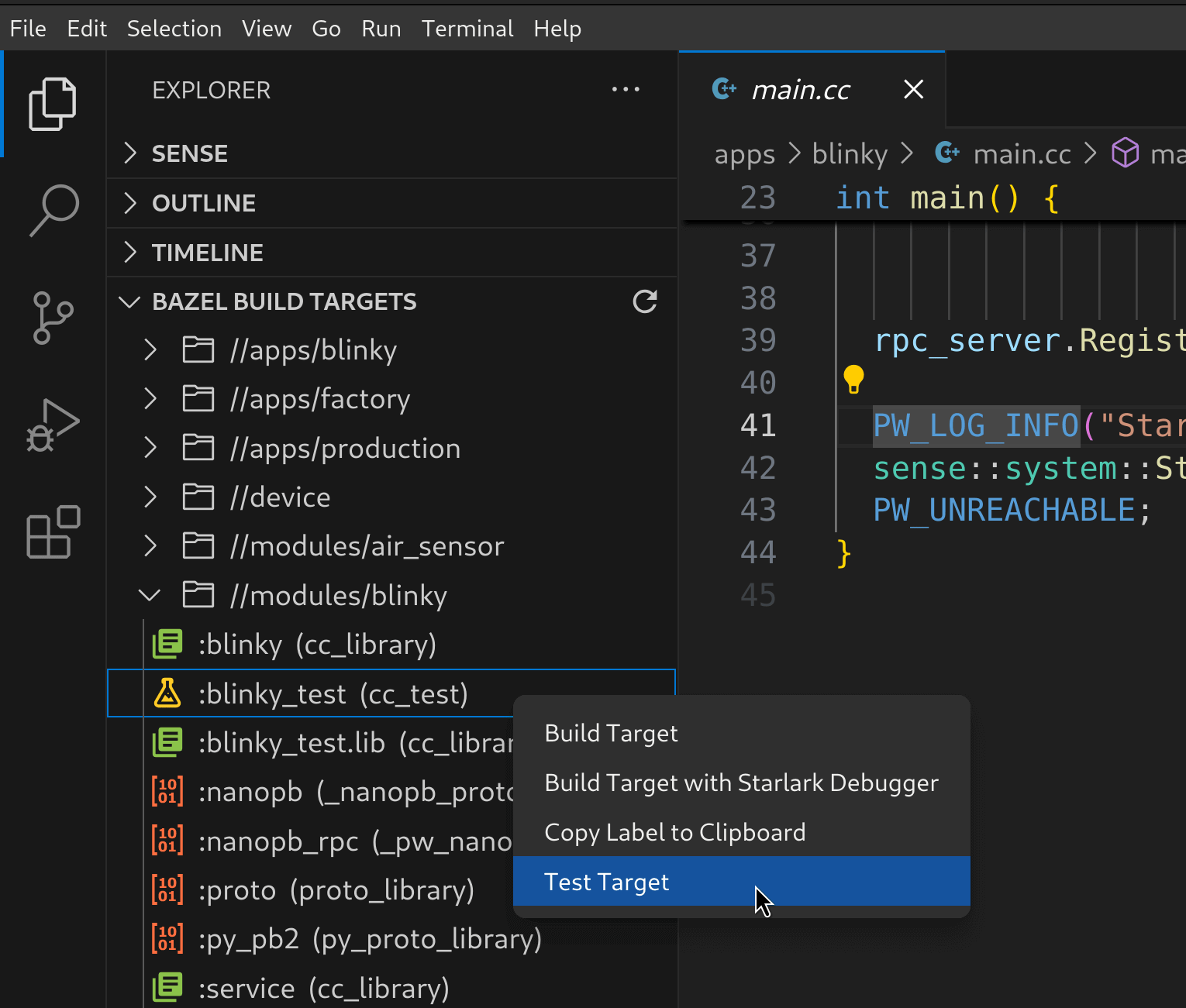5. Run host tests#
pw_unit_test provides an extensive GoogleTest-compatible unit testing framework. Before building and running the app, let’s first verify that the app’s logic is correct by exercising the app’s unit tests:
Open
//modules/blinky/blinky_test.cc.Remember that
//represents the root directory of your Sense repository. E.g. if your Sense repo was located at/home/example/sense/then//modules/blinky/blinky_test.ccwould be located at/home/examples/sense/modules/blinky/blinky_test.cc.Make the
Toggletest fail by changing one of the expected values. Example:TEST_F(BlinkyTest, Toggle) { // ... auto event = FirstActive(); ASSERT_NE(event, monochrome_led_.events().end()); EXPECT_EQ(event->state, State::kInactive); // add this line // EXPECT_EQ(event->state, State::kActive); // comment out this line EXPECT_GE(ToMs(event->timestamp - start), kIntervalMs * 0); start = event->timestamp; // ... }
Caution
Remember to save your changes!
Run the tests:
Make sure that your platform is set to host_simulator, as demonstrated in Navigate the code intelligently. If VS Code was displaying red squiggly line warnings in
blinky_test.cc, those should go away.In Bazel Targets expand //modules/blinky, then right-click :blinky_test (cc_test), then select Test target.

Starting
blinky_test#A task launches a terminal. You should see
blinky_testfail:INF LED blinking: ON INF [*] INF [ ] INF Stopped blinking [ OK ] BlinkyTest.BlinkSlow [==========] Done running all tests. [ PASSED ] 3 test(s). [ FAILED ] 1 test(s). ================================================================================ INFO: Found 1 test target... Target //modules/blinky:blinky_test up-to-date: bazel-bin/modules/blinky/blinky_test INFO: Elapsed time: 2.060s, Critical Path: 1.75s INFO: 27 processes: 15 internal, 12 linux-sandbox. INFO: Build completed, 1 test FAILED, 27 total actions //modules/blinky:blinky_test FAILED in 0.0s /home/kayce/.cache/bazel/_bazel_kayce/e6adb4cdc44e1f72d34a105431e60eae/execroot/_main/bazel-out/k8-fastbuild/testlogs/modules/blinky/blinky_test/test.log Executed 1 out of 1 test: 1 fails locally.
Press any key to close the terminal that was launched.
Tip
When you want to run all unit tests, open a VS Code Terminal and execute
bazelisk test //.... You don’t need to manually set upbazelisk, the Pigweed extension for VS Code sets it up for you.Run the tests with the following command:
Run the following command. You should see output similar to what’s shown after the command. The key line is
Executed 1 out of 1 test: 1 fails locally.bazelisk test //modules/blinky:blinky_testYou should see output similar to this:
INF LED blinking: ON INF [*] INF LED blinking: OFF INF [ ] INF LED blinking: ON INF [*] INF [ ] INF Stopped blinking [ OK ] BlinkyTest.BlinkMany [ RUN ] BlinkyTest.BlinkSlow INF [ ] INF PWM: - INF [ ] INF [ ] INF PWM: + INF PWM: + INF PWM: + INF Blinking 1 times at a 320ms interval INF LED blinking: OFF INF [ ] INF LED blinking: ON INF [*] INF [ ] INF Stopped blinking [ OK ] BlinkyTest.BlinkSlow [==========] Done running all tests. [ PASSED ] 3 test(s). [ FAILED ] 1 test(s). ================================================================================ INFO: Found 1 test target... Target //modules/blinky:blinky_test up-to-date: bazel-bin/modules/blinky/blinky_test INFO: Elapsed time: 2.032s, Critical Path: 1.69s INFO: 9 processes: 1 internal, 8 linux-sandbox. INFO: Build completed, 1 test FAILED, 9 total actions //modules/blinky:blinky_test FAILED in 0.0s /home/kayce/.cache/bazel/_bazel_kayce/e6adb4cdc44e1f72d34a105431e60eae/execroot/_main/bazel-out/k8-fastbuild/testlogs/modules/blinky/blinky_test/test.log Executed 1 out of 1 test: 1 fails locally.
Tip
To run all host tests, run this command:
bazelisk test //...Revert the test to its original state. Remember to save your change.
Run the tests again and make sure they pass this time.
You should see
blinky_testpass this second time:INFO: Analyzed target //modules/blinky:blinky_test (0 packages loaded, 0 targets configured). INFO: Found 1 test target... Target //modules/blinky:blinky_test up-to-date: bazel-bin/modules/blinky/blinky_test INFO: Elapsed time: 1.861s, Critical Path: 1.65s INFO: 4 processes: 4 linux-sandbox. INFO: Build completed successfully, 4 total actions //modules/blinky:blinky_test PASSED in 0.0s Executed 1 out of 1 test: 1 test passes.
Note
If you see warnings that begin with There were tests whose
specified size is too big, you can ignore them. If you encounter this warning
in your own project, it means you need to adjust the timeout of the tests.
Summary#
We know that unit tests are a little boring, but they’re an important part of Pigweed’s mission. When you’re on a large embedded development team creating a new product, it’s much easier to iterate quickly when you have confidence that your code changes do not introduce bugs in other parts of the codebase. The best way to build that confidence is to rigorously test every part of your codebase and to make sure all these tests pass before allowing any new code to merge.
Pigweed spends a lot of time making it easier for teams to test their codebases, such as making it easy to run unit tests on your development host rather than on physical hardware. This is especially useful when your physical hardware doesn’t exist yet because your hardware team hasn’t finished designing it!
Another reason why it’s important to make code that can be tested on your host: security and robustness. This enables you to run modern code analysis tooling like ASAN, TSAN, MSAN, fuzzers, and more. These tools are unlikely to run correctly in on-device embedded contexts. Fun fact: We caught real bugs in Sense with this tooling during development!
Now it’s time for the fun stuff. Head over to
6. Run the host app to try out the bringup
app, blinky.